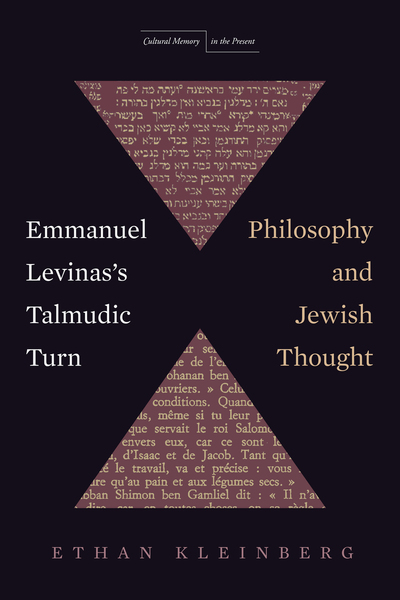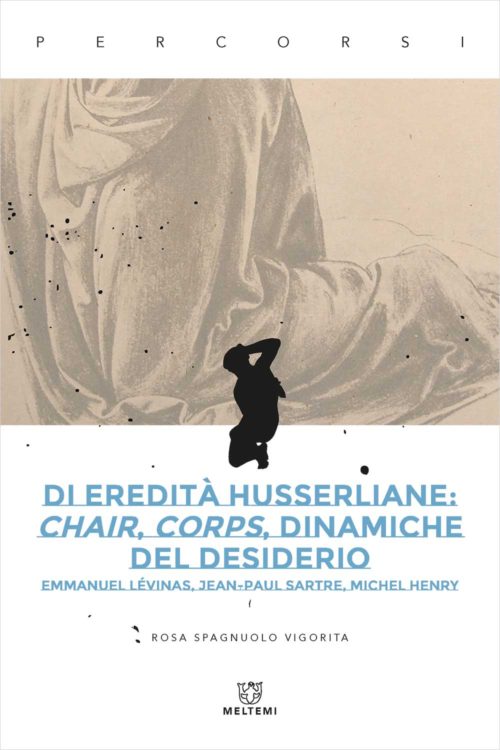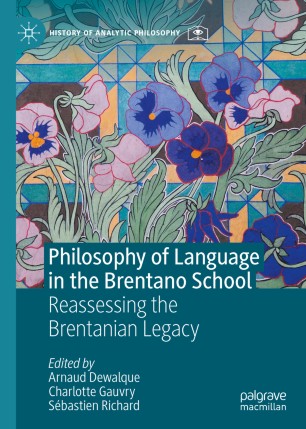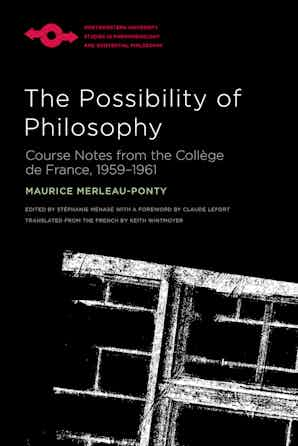 Emmanuel Levinas's Talmudic Turn: Philosophy and Jewish Thought
Emmanuel Levinas's Talmudic Turn: Philosophy and Jewish Thought
Cultural Memory in the Present
Stanford University Press
2021
Paperback $28.00
248
Reviewed by: Andrew Oberg
(Associate Professor, Faculty of Humanities, University of Kochi, Japan)
Reading Dialectically
1. Content and Structure
To begin, and with consideration for the nature of the journal in which this review appears, it should be acknowledged what this book is not: the work is weakest when it comes to philosophical analysis, for the most part providing descriptions of Levinas’ thought rather than interactions with it (although the latter is not entirely absent). I had expected otherwise and so this was somewhat disappointing, but – to slightly alter the old saying – perhaps we should not judge the book by the subtitle on its cover. The biographical information listed for the author tells us that Ethan Kleinberg is “the Class of 1958 Distinguished Professor of History and Letters at Wesleyan University” (this is also what is given on his institution’s faculty page), and a social media profile (for what such is worth, ours being the digital age) cites his PhD as being in History and Critical Theory. Thus, we should gear ourselves for history, and on that account the work is highly interesting and the reader does indeed gain much insight into Levinas the man from a careful reading of the text. This precisely – the act of careful reading – is the theme which I drew most from Kleinberg’s engaging and enjoyable presentation of Levinas’ Talmudic lectures as I journeyed alongside and through them, and the same shall become our concern in what follows.
A word or two must be given on the unique format that the book employs. Composed of six sections it is divided into four chapters that are flanked naturally enough by an introduction and a conclusion; the chapters, however, are “doubled” in the sense that each contains two separate columns of text which run parallel to each other: picture a single page with prose X on the left side and an entirely disconnected prose Y on the right; turn the page and X continues on as it had been still on the left with Y too carrying forwards on the right. In each of the chapters the right handed Y column ends before the left handed X, and therefore the final few pages simply have that side of the paper blank. It is admittedly not perfectly accurate to describe these two portions as “disconnected” however, for there is a thematic crossover between them which is related to Levinas’ life and personal educational mission. The left side sections offer biographical and institutional narratives connected to Levinas’ series of lectures on passages from the (Babylonian) Talmud delivered to the Colloque des intellectual juifs de langue française in Paris from 1960 to 1989, with an emphasis on what Kleinberg calls the “braid” of Levinas’ influences from and emphases on the trio of Western philosophy, French Enlightenment Universalism, and the Lithuanian Talmudic tradition. (See p. 12; Levinas had learned Talmud study under the mentorship of the well-known but perhaps mysterious Lithuanian master Shushani, being originally of Lithuanian stock himself although his family was forced to flee there for Ukraine after the German invasion of Lithuania in 1915, returning finally in 1920, only for Levinas to decide to leave again to attend university in France in 1923; these and other fascinating details are given in Chapter 1.) The right side sections relate to the content of the lectures themselves, titled respectively: “The Temptation of Temptation” (Shabbath, 88a and 88b); “Old as the World” (Sanhedrin, 36b-37a); “Beyond Memory” (Berakhot, 12b-13a); and “Contempt for the Torah as Idolatry” (Sanhedrin, 99a and 99b; note that the transliteration for these tractate names varies slightly from source to source, here I am simply following the spelling given in Kleinberg’s book).
The biographical (left) portion is further categorized as “Our Side” and the Talmudic (right) as “The Other Side” at the opening of each chapter, and these divisions are references to what Kleinberg outlines in the introduction as Levinas’ formulae – after Rabbi Hayyim of Volozhin, founder of the famed Volozhin Yeshiva – of “God on our side” and “God on God’s own side”: that is, for the “God as revealed in our finite and imperfect world and as such limited by that which we can conceive or imagine” and “the infinite and absolutely transcendent qualities of God that lie beyond our finite abilities to define, conceive, or even name God” (p. 5). We are additionally warned that we must take care (this from Levinas’ thinking) not to presume that what we know from “our side” can be understood as “the essence of God or we reduce God to a mere product of our imagination” (also p. 5). Clearly this makes for a healthy alert prior to any approach for or about the numinous, but there is also a methodological risk here in that these alignments could become useless if taken too seriously, such that the attempt to query and seek God on “God’s side” – however tentatively – is thereby perfunctorily given up; we must have some tools to work with, and moreover the courage to so work. We will therefore try; initially by taking Kleinberg’s “our side” texts before shifting to his “other side”, and finally offering some general summative remarks.
2. “Our Side”
Levinas is probably best remembered for his ethics, and as Kleinberg relates it this in part formed the impetus for Levinas’ pre-war move from Husserl to Heidegger, that it was “through the realization that there was no place for ‘others’ in Husserl’s phenomenological program” and hence the shift to a Heideggerean perspective (one thinks here of Heidegger’s emphases on embedded “world” issues, on Dasein as entering a historical trajectory already “in progress”, and on the necessity of a subject-bound hermeneutics as opposed to (the illusion of) objectivity) which provided Levinas with “themes [that] returned in Levinas’s later writing and in his Talmudic readings when they were recast in relation to his renewed emphasis on Jewish thought” (p. 29). After the war, in the dreadful awakening to the horrors of what came to be called HaShoah (The Catastrophe: the Holocaust) which confronted every thinking and feeling person, but of course most forcefully Europe’s surviving Jews, Levinas re-situated his own commitments to begin to place “his philosophy in terms of his Judaism: ‘My philosophy [this is a quote from Levinas found in the collection Carnets de la captivité (Notebooks from Captivity) published in 1946; he was a prisoner of war] is a philosophy of the face to face. The relation with the other without an intermediary. This is Judaism.’” Hereafter he also withdrew from Heidegger, and he enacted “the substitution of ‘Being-Jewish’ for Dasein” (p. 36).
This particularization and un-finitizing (this blurring) of the self and its place in the cosmos moreover entailed for Jewish identity a necessary tie to the past (election, and therefrom responsibility) within the still-not-yet of the promised messianic future, and it is this orientation to time that distinguishes “Being-Jewish” from, for example, the present focuses of Christianity with its “born anew”, or science with its discovery, or politics with its revolution. Therein lies “the fundamental difference between the ontological meaning of the everyday modern world and the ontological meaning of Being-Jewish” (p. 50). It might be objected at this point that Christianity, science, and politics do each clearly look to their own futures – and in the instances of “new birth”, discovery, and revolution especially so – but perhaps the idea here is that the stresses are on something akin to “May we have it now (new birth, discovery, revolution)” rather than the “split” “Being-Jewish” mindset which always has one eye over its shoulder, as it were, gazing both to the was-then and simultaneously the will-be.
On this issue of identity Kleinberg also locates what he describes as a “blind spot” for Levinas, a level at which he “conserves aspects of the authentic/inauthentic distinction inherited from the philosophy of Heidegger”; evidently this is through the relating of an assimilation into the broader culture with an inauthentic mode of “Being-Jewish” (p. 52). There is an interesting argument here in the sense of assimilated life as less “validly Jewish”, and therefore as juxtaposing with Heidegger’s inauthenticity as less philosophically realized, but for Heidegger inauthenticity was the “thrown” and default condition of the “they” (i.e. everyone) and Dasein needs to make (great) efforts to achieve authenticity, whereas the opposite is the case if one is born into the Jewish lineage: there the efforts required are for assimilation (moving out of one’s heritage, and having to try to be accepted as having so moved out by the “mainstream”), and hence the conceptual matching that Kleinberg asserts is not a perfect fit. Then too we might ask how thin the line is (or should be) between embrace and exclude when it comes to matters of identity, a question that ethically and existentially matters tremendously. Concern for the other is certainly at the core of Judaism, but if each other is always viewed in terms of “Being-Jewish” and vis-à-vis the kind of ranking system thereby implied, then that concern must become colored or even tainted; yet again, if we place ourselves historically in post-war Europe we find our sympathies are unreservedly extended to this manner of thought. It might be that the us/them aspect of any identity simply cannot be rid of the paradoxes and double-edges that adhere: that to ever assert any version of “we” is always and necessarily to negate it in a “they”. Whatever the case may be, this is a critique that Kleinberg returns to in his fourth chapter wherein he cites scholars who have been critical of what they label a hierarchy of people and cultures within Levinas’ writings and, as Kleinberg illustrates, his Talmudic lectures.
Let us though transition from ethics as point of view into ethics within/by/as text (scripture and exegesis), mindful of our stated theme of a “careful reading”. The Talmud came to be central to Levinas for his project of an ethical humanism – the responsibility for the other, facing the other and the taking on of accountability beyond the mere confines of one’s own acts – and that, “For Levinas, ‘the Bible clarified and accentuated by the commentaries of the great age that precedes and follows the destruction of the Second Temple, when an ancient and uninterrupted tradition finally blossoms, is a book that leads us not towards the mystery of God, but towards the human tasks of man’” (p. 73; emphasis in the original). It is the reading of the book (Bible) and the reading of the writings on the book (Mishnah, Talmud, et cetera) that properly conditions one to become a creature who can care, and this understanding both motivated Levinas in his pedagogical objectives and in his – shall we say – seizing of the Talmud away from its customary place in the yeshiva and thrusting it into the academy. Levinas, Kleinberg informs us, “wanted to take control of the chain of transmission, to prolong the spirit of Shushani, and thus to fulfil the call to transmit what has been heard. In essence, Levinas sought to start a new tradition, a new chain of transmission, in keeping with his goals for Jewish education, his reformulation of Judaism as a humanism” (p. 83). This then places us back at the beginning, and the Talmudic lectures themselves.
The initial 1959 lecture that Levinas delivered to the series of colloquia (given at the second commencement, he did not speak at the inaugural meeting) was on the influential philosopher and theologian – or maybe more properly: philotheologian, or theophilosopher – Franz Rosenzweig, but at the third event he presented a Talmud lesson opposite another’s biblical lesson (André Neher; see p. 94). At the time this was quite remarkable; Ady Steg, who would become the president of the Alliance Israélite Universelle from 1985 to 2011, recalled that: “The Bible was familiar to the intellectual world, to the non-Jewish world as well. But the Talmud was something totally ignored, reserved for those good Jews with long beards from Poland to Morocco. The idea that the Talmud could be studied in French, in public, and in the same manner that it was studied by Jews from eastern Europe or from Maghreb [northwest Africa] was extraordinary” (pp. 94-95). This was to become the motif for the years that followed. To Levinas, who accepted the being of God/“God” (I add the scare quotes to allow this concept some attitudinal flexibility), and the subsequent central position God/“God” attains through recognition, an associating with and/or orienting towards the divine was not to be done in the kind of non- (or anti-)rationalist ways that are typical of traditional religion, but instead via the same critical and reason-based thinking which is common in scholarship (p. 112). At numerous points Kleinberg refers to this as Levinas’ “religion for adults”, and the notion seems to have been one that was both dismissive and upholding vis-à-vis faith: denigrating “feeling” faith while lauding “thinking” faith would perhaps be one way to put it. Thus, for Levinas the sacred books were that – sacred – and were moreover of greater value than their interpreters and the schools of interpretation which history has granted alongside them; it is “the text that serves as the conduit or pathway to God on God’s own side” (p. 111). Kleinberg, commenting in general but also specifically about Levinas, remarks that we as readers should not depend upon “the genius of the reader or the writer” but rather “we should look to the transcendent meaning of the text, the opening to the Other that always retains the potential to say more than it says” (p. 126).
There is surely much wisdom in this, but it should also be noted the way that such an approach leaves the door ajar for relativism; Levinas did, it appears, insist on a proper training for taking from the Talmud (adhering to and promoting the method he learned from Shushani), but to bequeath the text (any text) with a “something beyond” is to give it a mysticism that supersedes its actual content (such as is signaled by “conduit”, “pathway”, “opening”, et cetera), and this is a facet of reading that both Levinas and Kleinberg seem comfortable with. Thereby the word can be made to “say” anything, and thusly to actually mean nothing. Yet there is, I think, another possibility here, and that is not to be bothered by this relativism so much as to embrace it in a particular way, to adopt a hermeneutics of the moment, and in this phenomenological reading to take care for the written meaning that one finds from within one’s place at one’s present, without making the additional move of affixing definitiveness to that. We are all, I suppose, postmoderns in this denial of a single, permanent interpretation, but in this latter now-construct just offered it is not a case of everything being there because no-“thing” is “there”, rather that what is there is indeed there but its instantiation rests within a spectrum of potentialities. The text is rooted, what it offers is limited, but even so with a depth that the surface might mask.
These thoughts call to mind Levinas’ concern for dissociating oneself from the prejudices of time, and as we suggested that a reading can be repetitious without ever being repeated (returned and returned to for re- and re-readings without ever finding the same set of results), Levinas advised that we leave aside “what we might call the bias of the modern that includes the presumption that we now know more and better than those who came before us” (p. 161). We do not of course, we merely know differently (as regards the humanities at least, for empirical matters the case is naturally distinct). In such a way Levinas was prepared to let the Talmud, through his “religion for adults”, speak its archaic words to contemporary readers and hearers, and in this he found too (the idea of) God/“God” as the “ethical ground or backstop that keeps reason from devolving into sophistry or the will to power…as the inspiration for good, for Ethics” (p. 138). It will be recognized how close this is to God/“God” as the “call” of writers like John D. Caputo, although on my understanding I suspect that Levinas would give a “meatier” rendering to God/“God” than Caputo might. On this note of the other, then, let us now turn to Kleinberg’s second (the right hand side) column of text – his “The Other Side” – in order to better explore the Talmudic lectures themselves.
3. “The Other Side”
The talk which Kleinberg chooses to begin with concerns itself with what Levinas calls “the temptation of temptation”, namely “the need to make the determination and offer an answer [which then] ascribes that meaning and, in doing so, wrests the event and the possibilities latent in its occurrence away from the Other…creating a closure instead of an opening” (p. 18). As we have here been contemplating, this is quite deleterious to a reading (now-constructed or not) that would be able to take – and be enabling of – an ancient source and apply its voice to the present. Whatever the participants whose discussions are recorded in the Talmud may have had to offer on this or that, the instant we affix Correct Interpretation M to such data then A through L along with N through Z disappear into the aether, leaving us not only the poorer for it but the text itself too greatly reduced. The passage on the page might “be” M now, but we must by all means resist the urge to make it ever-M; and, we may add, the related prompting to make my M forcefully become yours (after all, you could be reading N or O or P, and then let us talk about that and see if we do not in the end arrive at Q, or L). Such dialogical/dialectical proceedings (we will have more to add on this below) are of course not only in accord with the way of the Talmud, they are the way of the Talmud, and as Kleinberg writes, “Levinas instructs us to ‘enter into the Talmud’s game, which is concerned with the spirit beyond the letter, and is, for this reason, very wonderful’” (p. 64).
As an example of this, Kleinberg remarks that for Levinas the history of an institution such as the Sanhedrin “is unimportant, even its historical existence. What is important are the lessons that have been drawn from the Sanhedrin” (p. 55); and by reflecting on this once again we may find our now-construct reading with its rooted but broad word-trees, its textual branches. It does not matter one bit if the Sanhedrin sat in deliberation as is described, nor if its hallowed judges ever lived, what does are the manners by which these stories have been taken and applied to the lived situations of those who read and heard them. This is how the book attains (or is given) timelessness, how it instructs from its own side the reader as hearer as interpreter who then must do something with it today, irrespective of the “when” of its contents. However, in thinking thus we need to also recall the above caution about the inherent spectrums within the words and passages, the caveat that whatever the beauty and the intuited or claimed transcendence of a text, such will never be capable of fully standing outside history (arguably nothing can) and therefore will always be connected to the era of its production and the subsequent recorded interactions of the person(s)/community(ies) with the word. Again, Levinas’ “Being-Jewish” (we might substitute “reading-Jewish(ly)” here) that is at once backwards and forwards-facing. Kleinberg summarizes this aspect with: “the memory need not correlate to an ‘actual’ historical event. This is to say that the ‘memory’ of the exodus from Egypt need not be a memory of something that actually happened but instead the memory must be such that it carries the future within it. The promise for the future is more important than the fidelity to the past” (p. 96). This, I think, is not only indicative of the value a perspective can have but also of that for narratives, for myths and storytelling, for those repeated and beloved tales whose truths are in the virtues they (seek to) impart rather than the information they present. Superman, for instance, never “happened”, but his call for social justice and the championing of the weak (incidentally, highly biblical qualities) are as relevant today as they were when the comic first appeared in 1938; Levinas would no doubt make a very similar remark about the more complex and venerable biblical and extra-biblical incidents with which the Talmud concerns itself (not to compare the two!).
Within this very aspect of the text as having value and being loved, however, lies another danger which Kleinberg introduces in the final lecture he considers: “Contempt for the Torah as Idolatry” (Chapter 4). This is to take the Torah as itself an item due veneration, and Levinas counters this tendency (or temptation) by advising that – as Kleinberg puts it – “The general or universal rule is never enough and must be brought into contact with the actualities of the day [i.e. the reader’s time and place]. Invariable conceptual entities are to be avoided, perhaps, as one resists an idol” (pp. 130-131). For Levinas, a Jewishness which is based on a book (Torah) is that in which one is perforce a student, a reader, and it seems transparent enough that this is the kind of “Being-Jewish” that Levinas wishes to promote. The way, then, to avoid crossing the identity-based matter of “reader” with the commingled risk of an excessive reverence for the object of study is to seek to always read through what might be called a properly dialectical procedure, to move beyond mere dialogue with the words (itself already an improvement on a simple imbibing of the words) and into a realm where the text becomes an Other both affirmed and negated in a synthesis which produces something ever-ongoing: Kleinberg explains, “It is not the context in which the Torah was given that is important nor its status as a religious object. It is the act of reading and interpreting the Torah that brings Revelation to life” (p. 146), and therefore the “right and productive way [to engage the Torah] sees that the Torah must be studied, argued, and debated to be maintained. The wrong way is to take the Torah as a finished product worthy of worship in itself” (p. 148). A good reader, a non-idolatrous reader, will be someone who takes the pages as partners for interaction, who finds in them promptings that are always new and timeless precisely because they are timely, because they are connected to and responsive towards the needs of the moment: unlocked, unshackled from the past which birthed them and which must still nevertheless be known yet without allowing that information to circumspect their potential today. Kleinberg very colorfully describes the opposite of the dynamic approach just outlined as a version of “dogmatism” that “results in a harvest that cannot be consumed because the sowing has ceased” (p. 150). The message – its meaning, exercise, possibly even assessment – must be queried, argued, and found from what thereby emerges: again and again, world without end. The summary Kleinberg gives for Levinas’ focus is that, “Studying must not be a devotion in the sense of piety to an immobile code or rote memorization but a motion forward that reveals the way that such a self is always a work in process, a construction, an other me that can be a better me. As such, it is also an opening to the other” (p. 151).
It will be realized that the “self” of these concerns – for Levinas – is naturally connected to “Being-Jewish”, and Kleinberg transitions in his conclusion to contemplate some critics of Levinas’ work on these matters who find a (perhaps unbeknownst) favoritism or elitism within them that promotes his own in-group above all others. This is a matter of deep gravity for any system that would orient itself ethically, as both Levinas and the Talmud itself does, and moreover for one also dedicated to the legacies of Western philosophy and French Enlightenment Universalism (as Levinas was, outlined above), but it is also one terribly complicated by the “facts on the ground” of Jewish existence that at least in its Diaspora but possibly – in this globalized world – even in Eretz Yisrael faces regular threat and pressure to “be” elsewise. Levinas had lived through the Second World War, he had lost his family to the horrors of its pogroms, and he took it upon himself to struggle to assert a Jewish identity that could be proud and noble without retreating into either what he viewed to be a naïve form of Orthodoxy or a self-negating assimilation in the wider European (or other) culture: both of which would be a disappearance. Kleinberg wonders if these longings might not be extended further than the default exemplarism that comes part and parcel with membership-by-birth, reasoning that it is perhaps via a personal approach wherein such could be found: “He [Levinas] sought to make the past present for the future by blowing on the coals and reigniting the fire that he believed lives within the sacred texts of Judaism. It is in the relationship that we each can have with the text and not through the institutions that guard them” (p. 179). I sympathize with these thoughts, and certainly agree that almost limitless wisdom can be mined from the vast catalogue of writings that Judaism in its many formations has produced over the millennia, but I judge that too much structuring of self and personhood occurs from inside a belonging to permit a similarity of (let alone an equality of) reception to take place. “Being-Jewish” is something one cannot have without the constructive accoutrements that affix from the multitudinous angles of a people and a culture. Levinas wished to help his half-assimilated and/or “hidden” cohorts embrace themselves through his “religion for adults”; and with that as goal, and seen from inside that mindset, I think the preferentialism we can find in these lectures is probably inevitable. For the purposes they serve, moreover, that might not be a negative point.
4. A (Re-)Return to (Re-)Reading
In his turn to Talmud we find in Levinas a “return”, and thus we must invoke the concept of teshuvah, the “turning back” from having “gone astray” or – more colloquially – from “missing the mark”. We have not done what we ought to; we have not been as much as we could have; we have not lived up to our potential, or our calling. The challenge, the beckon, is always there: do (be) better, more. Levinas’ was a mission of education and encouragement, to go back and back and back to the text to seek from it what one may need in the moment for that moment, knowing full well that there can never be a mastery and that each re-reading is a confrontation anew. Kleinberg has given us an excellent snapshot of this facet of the great philosopher, of this piece of time within the man’s life, the concerns that enshrouded it and the motivations that animated it. The “stacked” or “doubled” nature of the four chapters that each contain biographical narratives alongside excerpts from and comments on the Talmudic lectures compel the reader to decide which he will engage with first (a strategy Kleinberg outrightly states in his introduction: this is the point of his arranging the book this way), and the choice may be self-revelatory in one way or another. Whether that is the case or not though, the opposite tack can thereafter be taken upon a second reading (“Our Side”/“The Other Side”: “The Other Side/“Our Side”; or vice versa), a notion one suspects Levinas would agree with (and probably Kleinberg be pleased by). The issue is a fittingly Jacobean one of “wrestling with God” (Genesis 32), of trying and trying and trying, of never giving up despite openly recognizing that there can be neither a completion nor finality. Kleinberg demonstrates how the Talmudic talks can be placed into Levinas’ broader oeuvre, and thereby how the treatments given in their contents might be matched with our own era and struggles for identity, purpose, and meaning. Levinas, along with his earlier contemporary and fellow imaginatively thinking European Jew Martin Buber, was an intellect of the other, of ethics, of relation. This too is a journey that does not end, but through our constant revisiting – and re-pondering – of the texts that help us on the way, may it be we find companions as provocative as these.







